In chapter 7 Fanny has the headache and is caught out by Mrs Norris for lying on the sofa. Here is a post from the L&T archives.
Here are three examples of sofas taken from the noted furniture designer, George Hepplewhite’s book The Cabinet Maker and Upholsterer’s Guide (third edition, 1794).
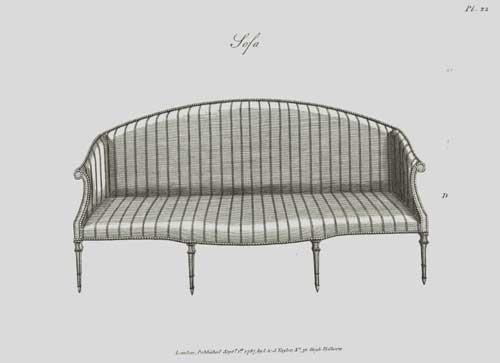
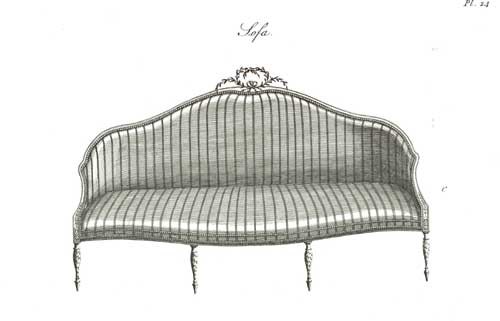
There are six in all illustrated in the book, but these give you a good idea of the type of furniture that JA writes about in Chapter 7.
This is what Hepplewhite had to say about sofas:
Plates 21, 22, 23, 24 present four designs for sofas; the woodwork of which
should be either mahogany or japanned, in accordance to the chairs; the
covering must also be of the same.
The dimensions of sofas vary according to the size of the room and pleasure of
the purchaser.
The following is the proportion in general use: length between 6 and 7 feet,
depth about 30 inches, height of the seat frame 14 inches; total height in the
back 3 feet 1 inch.
Plate 25 shews a design for a sofa of the newest fashion; the frame should be
japanned with green on white ground, and the edges gilt, the covering of red
Morocco leather
Here is Plate 25.
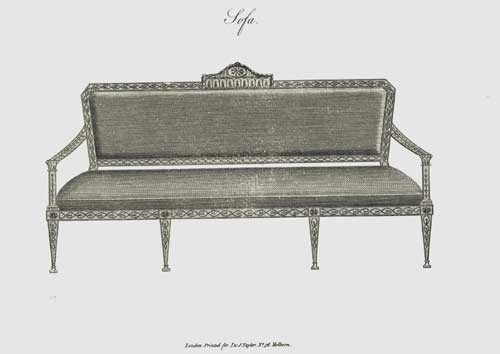
I should imagine the sofa was something like these above.
As to the situation with regard to lighting, Ellen Moody in her Chronology for Mansfield Park, estimates that this scene in takes place at the end of July. Even though it was a summer’s evening, between ten and eleven o’clock, it would still be dark.
So Fanny, away from the main lighting in the room may indeed be hidden in the shadows on the sofa. Now, as to whether it is deliberate slacking, or just because she is exhausted with a headache that she is hidden in the shadows, I leave you to determine.
Trying to envisage lighting in these rooms from our perspective, is rather difficult when we are used to the brilliance of modern electrical lighting.
Do take a look at this interesting picture dating from 1820 by Henry Sargent, of a tea party in New York.
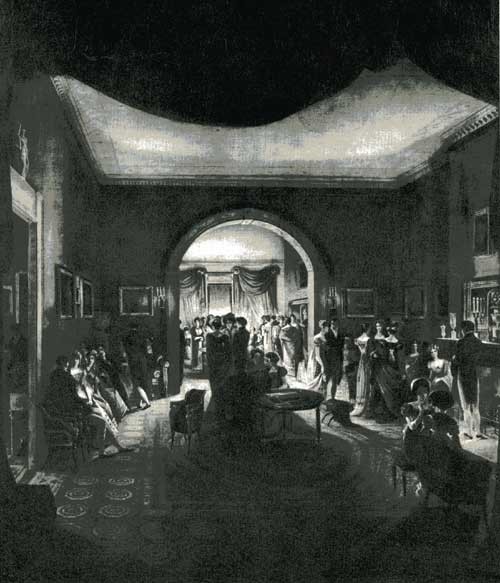
This is a very rare illustration of lighting characteristic in a house at that time and it shows how guests would have used a formally arranged room. The light sources are the branches of candles arranged on brackets or torcheres. Candles in candlesticks are placed near overmantle looking glasses to multiply the light, and there is also light from the fires.
Now, applying this to the long room at Mansfield, I’m not sure that the
fires would have been lit in Mansfield Park on a night at the end of July, so I
think it safe to assume that the only source of light in that long room would
have been candles.
You can see from this picture that there are pockets of very dark areas (see
the centre of the room pictured) and it is no doubt that poor Fanny became
invisible and forgotten taking rest on the sofa after her exhausting day in the
hot sun.
Here is another picture of a more modest establishment.
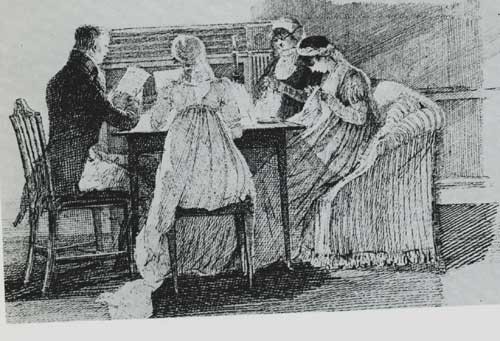
This is a drawing by John Harden; one of a series showing how people used to group themselves in their rooms according to light and heat sources. They are the equivalent of a modern day snap shot and I find them fascinating.
John Harden was a gentleman and a talented amateur artist who was on friendly terms with many professional artists such as John Constable. In 1803 he married the daughter of an Edinburgh banker and in 1804 took the lease of Brathay Hall in Westmoreland. His drawings, which date from 1804 show how active an early 19th century family could be – reading, writing, painting, sewing, often grouped around a table, particularly at night when they could share the light of the candles reinforced by the light from the fire.
As the sadly missed John Cornforth wrote about these pictures in his book English Interiors1798-1848: The Quest for Comfort:
Few pictures illustrate so graphically the lighting of rooms at that
period. They also show the mobility of furniture and the way an informal
impression arose from picking up sewing tables and placing them where needed.
Page 132.
The picture above shows that ladies were able to sew in this type of light. Obviously it depended on the eyesight of the individual, but yes, it could be done.
I think that P2 and S+S2 did a very good job of showing just how little light as available in the evenings in these rooms, unless chandeliers were involved and a place was very brightly lit for an assembly or rout.
